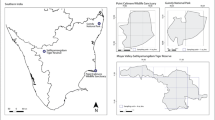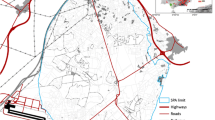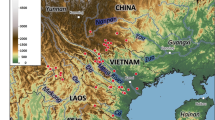Abstract
Mediterranean semi-arid landscapes are currently experiencing accelerated land use changes which are affecting species distributions. An important fraction of the European short-toed eagle (Circaetus gallicus) population, a specialised snake predator, breeds in this kind of landscapes. Information on the habitat characteristics that may affect the occurrence of this species is of paramount importance to try to evaluate how this species could be affected by ongoing territory changes. In this study, we use hierarchical partitioning analysis to identify environmental variables (natural vegetation, agricultural uses, hydrological web, topography, human pressure and climate) at two resolution scales (1 and 4 km2) that may influence the presence of the short-toed eagle in a populated Mediterranean region in southeastern Spain. Results were highly consistent between scales. Forest was the most important variable determining the presence of the short-toed eagle in the study area, showing a positive effect, particularly those inland forests with nearby presence of sunny open scrublands where the species may find its prey. On the contrary, herbaceous crops and all variables related to human pressure, including urbanisations, dispersed houses and roads, are negatively affecting the occurrence of the species. These variables are strongly related to the main driving forces that change landscapes in our study area, including the abandonment of traditional territory uses and the expansion of urbanised areas. These results indicate that the increasing number of housing developments projected in inland areas would have a detrimental effect on the short-toed eagle, especially if they are located close to pine forests and rivers.

Similar content being viewed by others
References
Arim M, Marquet PA, Jaksic FB (2007) On the relationship between productivity and food chain length at different ecological levels. Am Nat 169:62–72
Bakaloudis DE, Vlachos CG, Holloway GJ (1998) Habitat use by short-toed eagles Circaetus gallicus and their reptilian prey during the breeding season in Dadia Forest (north-eastern Greece). J Appl Ecol 35:821–828
Bakaloudis DE, Vlachos C, Papageorgiou N, Holloway GJ (2001) Nest-site habitat selected by short-toed eagles Circaetus gallicus in Dadia Forest (northeastern Greece). Ibis 143:391–401
BirdLife International (2009) Species factsheet: Circaetus gallicus. Downloaded from http://www.birdlife.org on 11/2/2010
Brambilla M, Rubolini D, Guidali F (2006) Factors affecting breeding habitat selection in a cliff-nesting peregrine Falco peregrinus population. J Ornithol 147:428–435
Bustamante J, Seoane J (2004) Predicting the distribution of four species of raptors (Aves: Accipitridae) in Southern Spain: statistical models work better than existing maps. J Biogeogr 31:295–306
Campión D (1996) La fragmentación de los ecosistemas mediterráneos y sus repercusiones en las rapaces. Quercus 122:23–24
Chevan A, Sutherland M (1991) Hierarchical partitioning. Am Stat 45:90–96
Cramp S, Simmons KEL (1980) Handbook of the birds of Europe, the Middle East and North Africa. Oxford University Press, Oxford
del Hoyo J, Elliott A, Sargatal J (1994) Handbook of the birds of the world, vol 2. New World vultures to guineafowl. Lynx Edicions, Barcelona
Donázar JA, Hiraldo F, Bustamante J (1993) Factors influencing nest site selection, breeding density and breeding success in the bearded vulture Gypaetus barbatus. J Appl Ecol 30:504–514
Fox J (2002) An R and S-Plus companion to applied regression. Sage, New Delhi
García-Ruíz JM, Ruíz-Flano P, Lasanta T (1996) Soil erosion after farmland abandonment in submediterranean mountains: a general outlook. In: Rubio JL, Calvo A (eds) Soil degradation and desertification in mediterranean environments. Geoforma Ediciones, Logroño, pp 165–183
Gil JM, Pleguezuelos JM (2001) Prey and prey-size selection by the short-toed eagle Circaetus gallicus during the breeding season in Granada Province (south-eastern Spain). J Zool 255:131–137
Guisan A, Zimmermann NE (2000) Predictive habitat distribution models in ecology. Ecol Model 135:147–186
Janes SW (1985) Habitat selection in raptorial birds. In: Cody ML (ed) Habitat selection in birds. Academic, San Diego, pp 159–188
Jiménez JE, Jaksic FM (1989) Behavioral ecology of grey eagle-buzzards, Geranoaetus melanoleucos, in central Chile. The Condor 91:913–921
Lasanta TJ, García-Ruíz M, Pérez-Rontome C, Sancho-Marcén C (2000) Runoff and sediment yield in a semi-arid environment: the effect of land management after farmland abandonment. Catena 38:265–278
Legendre P (1993) Spatial autocorrelation: trouble or new paradigm? Ecology 74:1659–1673
Lehmann A, JMcC O, Austin MP (2002) Regression models for spatial prediction: their role for biodiversity and conservation. Biodivers Conserv 11:2085–2092
Liberatori F, Penteriani V (2001) A long-term analysis of the declining population of the Egyptian vulture in the Italian peninsula: distribution, habitat preferences, productivity and conservation implications. Biol Conserv 101:381–389
López-López P, García-Ripollés C, Aguilar JM, García-López F, Verdejo J (2006) Modelling breeding habitat preferences of Bonelli’s eagle (Hieraaetus fasciatus) in relation to topography, disturbance, climate and land use at different spatial scales. J Ornithol 147:97–106
López-López P, García-Ripollés C, Soutullo A, Cadahía L, Urios V (2007) Identifying potentially suitable nesting habitat for golden eagles applied to ‘important bird areas’ design. Anim Conserv 10:208–218
MacNally R (2000) Regression and model-building in conservation biology, biogeography and ecology: the distinction between—and reconciliation of—“predictive” and “explanatory” models. Biodivers Conserv 9:655–671
MacNally R (2002) Multiple regression and inference in ecology and conservation biology: further comments on identifying important predictor variables. Biodivers Conserv 11:139–1401
Madroño A, González C, Atienza JC (2004) Libro Rojo de las Aves de España. Dirección General para la Biodiversidad-SEO, Madrid
Mañosa S (2003) Aguila culebrera, Circaetus gallicus. In: Martí R, Del Moral JC (eds) Atlas de las Aves Reproductoras de España.. Dirección General de Conservación de la Naturaleza—Sociedad Española de Ornitología, Madrid, pp 172–173.
Mañosa S (2004) Águila marcenca Circaetus gallicus. In: Estrada J, Pedrocchi V, Brotons L, Herrando S (eds) Atles dels ocells nidificants de Catalunya 1999–2002. Institut Catalá d’Ornitologia(ICO)/Lynx Edicions, Barcelona, pp 164–165
Martínez JE, Martín J, Seva E (1997) Paisajes amenazados de la cuenca mediterránea. Aplicación del SIG en el análisis de la dinámica de usos del territorio (1956–1998) en La Vall de Gallinera (Alicante–España). Mediterránea. Serie de Estudios Biológicos, 17, Universidad de Alicante, pp 51–60
Moreno-Rueda G, Pizarro M (2007) Snake species richness and shrubland correlate with the short-toed eagle (Circaetus gallicus) distribution in south-eastern Spain. Ann Zool Fenn 44:314–320
Newton I, Davis PE, Moss D (1981) Distribution and breeding of red kites in relation to land-use in Wales. J Appl Ecol 18:173–186
Oliver MA, Webster R (1990) Kriging: a method of interpolation for geographical information systems. Int J Geogr Inf Syst 4:313–332
Ontiveros D, Real J, Balbontín J, Carrete MR, Ferreiro E, Ferrer M, Mañosa S, Pleguezuelos JM, Sánchez-Zapata JA (2004) Conservation biology of the Bonelli’s Eagle in Spain: research and management. Ardeola 51:461–470
Peña J, Bonet A, Bellot J, Sánchez J, Eisenhuth D, Hallett S, Aledo A (2007) Driving forces of land-use change in a cultural landscape of Spain. In: Koomen E, Stillwell J, Bakema A, Scholten HJ (eds) Modelling land-use change. Progress and applications. Springer, Dordrecht, pp 97–115
Pérez-Cueva A (1994) Atlas Climático de la Comunidad Valenciana. Consellería de Territori i Habitatge. Generalitat Valenciana, Valencia
Quevedo DI, Francés F (2008) A conceptual dynamic vegetation–soil model for arid and semiarid zones. Hydrol Earth Syst Sci 12:1175–1187
R Development Core Team (2009) R: a language and environment for statistical computing. R Foundation for Statistical Computing, Vienna, Austria. ISBN 3-900051-07-0. http://www.R-project.org
Rivas-Martínez S (1987) Memoria del mapa de series de vegetación de España. Instituto Nacional para la Conservación de la Naturaleza ICONA, Madrid
Rivas-Martínez S (1995) Clasificación bioclimática de la Tierra. Fol Bot Matritensis 16:1–29
Rivas-Martínez S (1997) Syntaxonomical synopsis of the North American natural potential vegetation communities I. Itinera Geobot 10:5–148
Sánchez-Zapata JA, Calvo JF (1999) Raptor distribution in relation to landscape composition in semi-arid Mediterranean habitats. J Appl Ecol 36:254–262
SEO-Alicante (2001) Las Aves en Alicante. Anuario Ornitológico 1999. SEO/Birdlife-Grupo Local de Alicante, Alicante
SEO-Alicante (2002) Las Aves en Alicante. Anuario Ornitológico 2000. SEO/Birdlife-Grupo Local de Alicante, Alicante
SEO-Alicante (2006) Las Aves en Alicante. Anuario Ornitológico 2001–2003. SEO/Birdlife-Grupo Local de Alicante, Alicante
Serra P, Pons X, Sauri D (2008) Land-cover and land-use change in a Mediterranean landscape: a spatial analysis of driving forces integrating biophysical and human factors. Appl Geog 28:189–209
Suárez S, Balbontin J, Ferrer M (2000) Nesting habitat selection by booted eagles Hieraaetus pennatus and implications for management. J Appl Ecol 37:215–223
Thiollay JM (1968) Essai sur les rapaces du Midi de la France: distribution, écologie. Circaète Jean-le-Blanc (Circaetus gallicus). Alauda 36:179–189
Walsh C, MacNally R (2003) Hierarchical partitioning. R Project for Statistical Computing. http://cran.r-project.org/
Wisler C, Hofer U, Arlettaz R (2008) Snakes and monocultures: habitat selection and movements of female grass snakes (Natrix natrix L.) in an agricultural landscape. J Herpetol 42:337–346
Acknowledgements
We are grateful with all the people that have collaborated in the censuses for the Atlas of Breeding Birds from Alicante Province. Thanks are also due to the personnel of Centro de Recuperación de Fauna Salvaje de Santa Faz, Conselleria de Medio Ambiente, Agua, Urbanismo y Vivienda, Generalitat Valenciana, especially to Alejandro Izquierdo and Pedro Mateo who provided additional data on short toed eagle distribution and some information on environmental variables. We wish to thank also to Joaquín Martín and Eduardo Seva (Universidad de Alicante) who helped in the elaboration on the environmental database. The English was revised by N.C. Marchant, P. O’Conell, E. Kluen and P. Karell. Finally, we wish to thank two anonymous referees whose comments improved a previous version of the manuscript. This work is a contribution to the project REN2002-03395 founded by the Spanish Ministry of Education and Science. This paper is part of DP’s PhD thesis at the University of Alicante.
Author information
Authors and Affiliations
Corresponding author
Additional information
Communicated by C. Gortázar
Rights and permissions
About this article
Cite this article
López-Iborra, G.M., Limiñana, R., Pavón, D. et al. Modelling the distribution of short-toed eagle (Circaetus gallicus) in semi-arid Mediterranean landscapes: identifying important explanatory variables and their implications for its conservation. Eur J Wildl Res 57, 83–93 (2011). https://doi.org/10.1007/s10344-010-0402-0
Received:
Revised:
Accepted:
Published:
Issue Date:
DOI: https://doi.org/10.1007/s10344-010-0402-0




